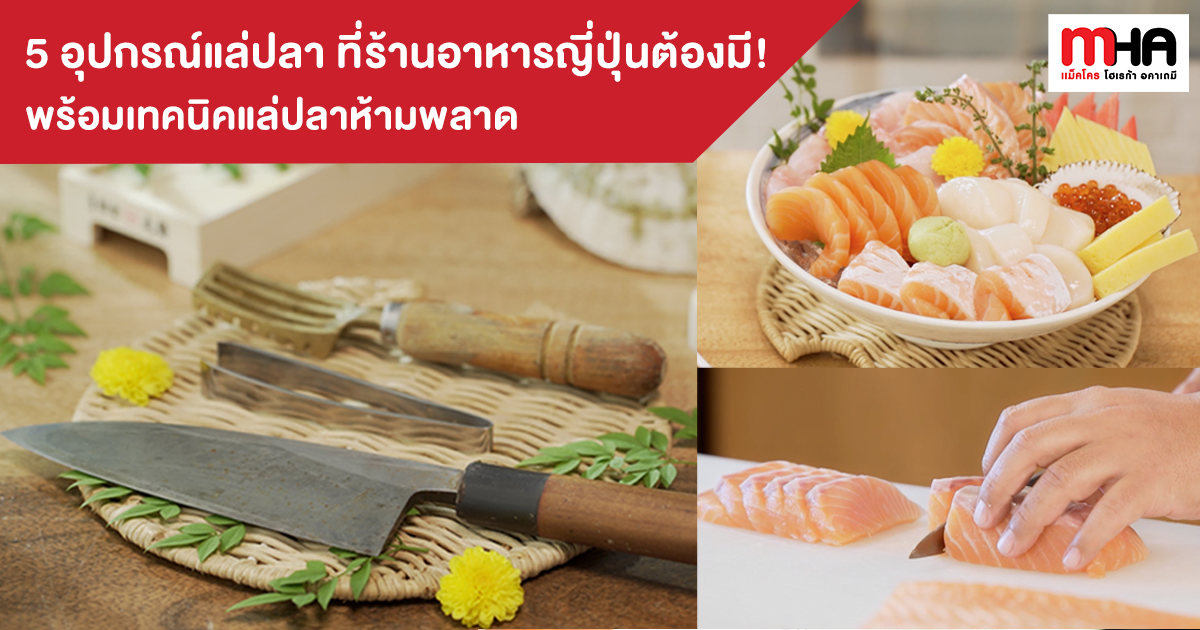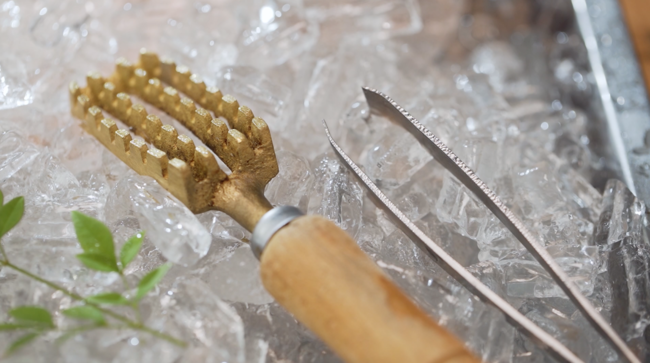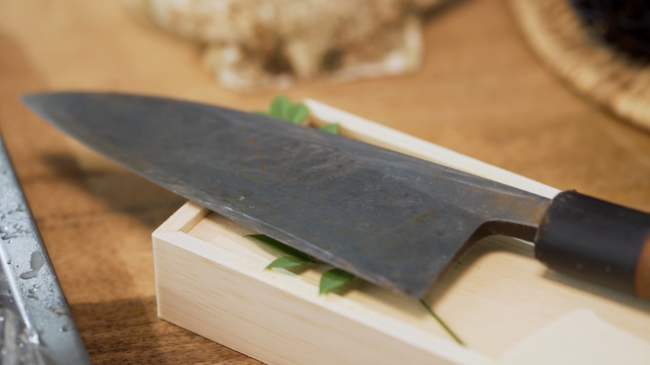Jul 14, 2020

5 Fish Slicing Equipment Japanese Restaurants Need and Fish Slicing Techniques You Can’t Miss!
Japanese restaurants are very popular in Thailand and a lot of people dream of owning one themselves. A Japanese restaurant might be one of the items on the list of restaurants people want to open and, of course, popular dishes in a Japanese restaurant include sashimi, sushi and various rolls, all of which use fish as the main ingredient. And slicing fish requires a lot of specialty equipment. Other than excellent recipes, fresh fish and skilled chefs, the equipment, particularly the knives, is essential in making Japanese food.
5 Types of Fish Slicing Equipment Japanese Restaurants Need
- Scalers specifically designed for removing fish scales. This makes it convenient to scale fish without damaging the fish meat. Scalers can be used on the scales of any fish, big or small.

2. Fish bone tweezers used for removing fish bones in the fish meat after the fish, such as salmon, has been filleted. Use your fingers to feel the bones in the meat. The bones are usually located in the upper half of the fish. Once the bones are removed, cutting or sectioning the fish meat will be easier and the bones will then pose no danger to your customers.

3. A Deba knife for filleting fish. This knife can cut bones without bending. Deba knives are the thickest Japanese knives. The tip of a deba knife is thin and curved, perfect for slicing fish along the bones. The heal of the knife is thick and suitable for chopping the neck bone to remove the head, although the knife is not usually used for chopping. The length of the knife is about 16.5 – 20 cm. The knife is used for sectioning different parts of the fish before the meat is sliced into sushi, sashimi or other fillings. The knife has to be wiped clean before being used on the next piece so as to not leave any odor or damage the fish meat.

Learn the steps and techniques for filleting fish in detail with our free online course, Million-Baht Sushi, taught by Chef Buntham Phakpho, Thailand’s Japanese iron chef and expert on Japanese cuisine with over 30 years of experience.
- Sashimi yanagi ba, a long sharp knife used to prepare fish for sushi or sashimi. The main objective of the yanagi ba is to slice raw fish, so the knife needs to be very sharp in order to cut even slices. The length of the knife is about 24 cm to 36 cm. The technique for using this knife is to place the index finger on the knife’s spine. The index finger is used to control the knife. Press the finger and knife down and the meat will be severed at the knife’s tip. Every slice has to end at the tip of the knife.

The technique for using this knife is to place the index finger on the knife’s spine. The index finger is used to control the knife. Press the finger and knife down and the meat will be severed at the knife’s tip. Every slice must end at the tip of the knife.

5. Steel chopsticks with sharp tips for handling pieces of fish. Regular chopsticks can be used as substitutes.

5 Fish Slicing Techniques You Can’t Miss!
Fish Scaling Technique
– Wash off the slime, so the fish isn’t slippery.
– When scaling, you can go ahead and put some pressure on the scaler because the skin will protect the meat and, particularly if the fish is fresh, the freshness will provide elasticity that will prevent the skin from easily tearing and the meat from turning to mush.
– When scaling, you have to turn on the water and rinse the fish as you scale it to check whether all of the scales have been removed.
– When scaling, you can go ahead and put some pressure on the scaler because the skin will protect the meat and, particularly if the fish is fresh, the freshness will provide elasticity that will prevent the skin from easily tearing and the meat from turning to mush.
– When scaling, you have to turn on the water and rinse the fish as you scale it to check whether all of the scales have been removed.
Technique for Cutting Salmon Heads for Added Value
– When cutting off the salmon head, you should leave a little meat on it so you can sell it later. Cut a little bit under the fin.
– When cutting, hold the knife straight, not slanted. You can use the heads for grilling with salt or boil them with soy sauce.
– When cutting, hold the knife straight, not slanted. You can use the heads for grilling with salt or boil them with soy sauce.

Technique for Creating a Hole in the Fishtail
– After the meat has been removed from the bones, make a hole in the tail, so you can use it to lift the fish. This way the meat retains its shape because you don’t have to handle it.
– After the meat has been removed from the bones, make a hole in the tail, so you can use it to lift the fish. This way the meat retains its shape because you don’t have to handle it.

The Weight of Fish Meat for Different Recipes According to Japanese Standards
– If you’re making sashimi, the weight per piece is no more than about 22 grams.
– If you’re making sushi, the slices should be on the long side. Each piece should weigh no more than about 16 grams.
– Fish for sushi can be cut in the middle so when customers dip it into the shoyu, the sushi goes down more easily and the shoyu is absorbed faster.
– If you’re making filling, such as for makizushi, each strip should be no more than about 20 grams.
– If you’re making sashimi, the weight per piece is no more than about 22 grams.
– If you’re making sushi, the slices should be on the long side. Each piece should weigh no more than about 16 grams.
– Fish for sushi can be cut in the middle so when customers dip it into the shoyu, the sushi goes down more easily and the shoyu is absorbed faster.
– If you’re making filling, such as for makizushi, each strip should be no more than about 20 grams.
Tips for Decorating Sashimi Platters and Arranging Sashimi Sets So They Sell Well
– Sashimi should be arranged more on the vertical side, not laid flat, on the platter for appeal.
– When arranging a set of sashimi, other than the raw fish for adults, you should consider everyone in the family to make it easier for customers to choose. For example, you can include some imitation crab in the set for children who don’t eat raw fish.
– Sashimi should be arranged more on the vertical side, not laid flat, on the platter for appeal.
– When arranging a set of sashimi, other than the raw fish for adults, you should consider everyone in the family to make it easier for customers to choose. For example, you can include some imitation crab in the set for children who don’t eat raw fish.

If you’re interested in opening a sushi restaurant, you can learn additional lessons with our free online course, Million-Baht Sushi, taught by Chef Buntham Phakpho, Thailand’s Japanese iron chef and expert on Japanese cuisine with over 30 years of experience!
Course Description
Chapter 1: Basics from the Sushi Guru
- Meaning of sashimi/meaning of sushi/types of sushi/basic knowledge before deciding to open a restaurant.
Chapter 2: Designing and Creating Sushi Menu Items
- Principles for designing the main menu items for a sushi restaurant.
- What additional items should a sushi restaurant have?
- Ways to create new dishes and add diversity by using the ingredients in the restaurant.
Chapter 3: Techniques for Cooking and Mixing Sushi Rice
- Sushi rice ingredients/cooking rice/mixing rice with vinegar/mixing sushi rice.
Chapter 4: Techniques for Slicing Fish for Sashimi and Dish Decoration
- Necessary equipment for slicing fish.
- Slicing a whole salmon.
- Sashimi dish decoration.
Chapter 5: Making Makizushi
- Hosomaki/futomaki/uramaki.
Chapter 6: Making Balled Sushi: Nigiri Sushi and Gunkan Sushi
- Nigiri sushi/aburi nigiri sushi/Thai wagyu aburi nigiri sushi/gunkan sushi.
